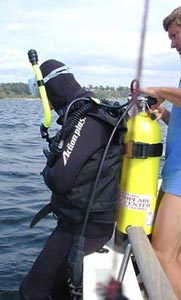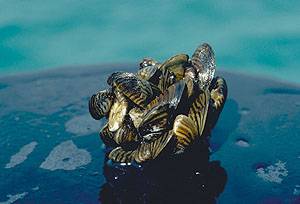Zebra Mussels
Air Date: Week of July 5, 2002
Zebra mussels are wreaking havoc in fresh waters all across North America. The non-native species eat the food of fish and plants, and clog intake water pipes to power and water treatment facilities. As North Country Public Radio’s Brian Mann reports, zebra mussels are also damaging historical underwater sea wrecks.
Transcript
CURWOOD: For years biologists have warned that an invasion of non-native zebra mussels threatens fish and plant species throughout the Great Lakes and other inland waters across North America. Now underwater archeologists say zebra mussels are also destroying historic shipwrecks. Brian Mann visited an underwater museum in Lake Champlain and has our story.
[SOUND OF WATER]
MANN: It’s mid-afternoon, and the haze floats over the dark green water as dive master Doug Jones ties his boat to a yellow buoy. Vermont’s green mountains rise in the distance. But my destination this morning lies below the waves: 40 feet down, on the silky bottom, sits the wreck of a ship known as the Burlington Bay Horse Ferry.
JONES: I suggest you do a tour around the wreck. It is possible to duck underneath part of the decking that’s there. Please don’t. It’s very fragile, especially the spokes to the paddle wheels that are sticking out.
MANN: The horse-powered ferry is one of six ships in Lake Champlain’s underwater historic preserve. Sites like this one are sprinkled throughout the country’s big freshwater lakes. From commercial barges to warships, archeologists say these wrecks hold a hidden chapter of our history.
JONES: Good.
MANN: Perched on the dive platform, I go through a final equipment check. I’m sheathed from heat to toe in a wet suit, insulation against the cold water.
JONES: Take a step out.
[DIVING SOUND]

Divemaster Doug Jones does a last gear check before reporter Brian Mann's descent.
JONES: Now, come on over here and hang onto the buoy.
MANN: Here in Lake Champlain, each wreck has its own buoy and a network of guide ropes to prevent novice divers like myself from bumping against the ship’s fragile timbers.
[SOUND OF BREATHING UNDERWATER]
MANN: After a pause to get my bearings, I slip below the surface. The water is ice-cold and thick with green silt, but soon I reach the bottom, and there it is, the bow of the ship peaking out of the shadows. I glide slowly past the delicate spokes of the paddle wheel and drift above the intricate exposed ribbing of the deck.
SABICK: The horse ferry is the only known example of this type of vessel in North America.
MANN: Back on shore, Chris Sabick is director of conservation at the Lake Champlain Maritime Museum. He’s built a half-scale model of the ship and its complex gears.
[SOUND OF MACHINERY]
SABICK: There was a vessel type that was fairly widespread during the nineteenth century, but it’s one of those vessel types that has slipped through the cracks of history and just kind of faded away.
MANN: You wouldn’t think that a murky lake bottom would be an ideal place to preserve a wooden treasure, but in fact, Lake Champlain’s chemistry is perfect: the fresh water is cold and calm; the silt actually protects artifacts from bacteria. Some wrecks have rested in lakes for centuries, completely intact. But now that’s changing. Sabick has added a box of tiny brown and white shells to the Maritime Museum’s display. The zebra mussel arrived in the United States in the late 1980s, carried in the ballast tanks of freighters traveling from Europe. Zebra mussels have spread rapidly throughout the Great Lakes, devastating whole ecosystems. They eat by siphoning away the phytoplankton that once supported the food chain. Native fish and plants starve and soon disappear altogether. Zebra mussels also build huge colonies. They’ve clogged intake pipes at power and water treatment plants, and they’ve anchored themselves to the timbers of hundreds of historic wrecks.

SABICK: The enormous weight of hundreds of thousands of these shells on waterlogged wood can obviously cause things to collapse.
MANN: Scientists studying sites like the Burlington Bay Horse Ferry have also found that zebra mussels actually change the water’s protective chemistry.
SABICK: It seems that the micro-environment that exists deep inside the mussel layer or colony attracts a type of bacteria that accelerates the degradation of the iron, and obviously all these shipwrecks are fastened with iron fasteners.
MANN: Over time, Sabick says, these wrecks could literally come apart at the seams.
[SOUND OF WATER]
Back in the water, I draw close to the horse ferry’s bow. Thick layers of zebra mussel shells coat the deck. In places, not an inch of wood is visible. Researchers say they won’t know for several years how much damage has been done here, but, without a way to stop the spread of zebra mussels, scientists fear that underwater museums like this one could be lost forever. For Living on Earth, I’m Brian Mann, in Lake Champlain.
[SOUND OF WATER BREATHING]
Links
Living on Earth wants to hear from you!
Living on Earth
62 Calef Highway, Suite 212
Lee, NH 03861
Telephone: 617-287-4121
E-mail: comments@loe.org
Newsletter [Click here]
Donate to Living on Earth!
Living on Earth is an independent media program and relies entirely on contributions from listeners and institutions supporting public service. Please donate now to preserve an independent environmental voice.
NewsletterLiving on Earth offers a weekly delivery of the show's rundown to your mailbox. Sign up for our newsletter today!
 Sailors For The Sea: Be the change you want to sea.
Sailors For The Sea: Be the change you want to sea.
 The Grantham Foundation for the Protection of the Environment: Committed to protecting and improving the health of the global environment.
The Grantham Foundation for the Protection of the Environment: Committed to protecting and improving the health of the global environment.
 Contribute to Living on Earth and receive, as our gift to you, an archival print of one of Mark Seth Lender's extraordinary wildlife photographs. Follow the link to see Mark's current collection of photographs.
Contribute to Living on Earth and receive, as our gift to you, an archival print of one of Mark Seth Lender's extraordinary wildlife photographs. Follow the link to see Mark's current collection of photographs.
 Buy a signed copy of Mark Seth Lender's book Smeagull the Seagull & support Living on Earth
Buy a signed copy of Mark Seth Lender's book Smeagull the Seagull & support Living on Earth

